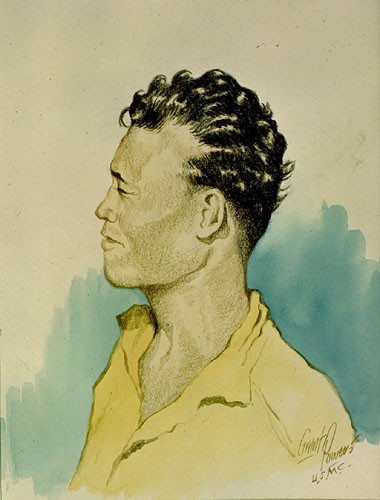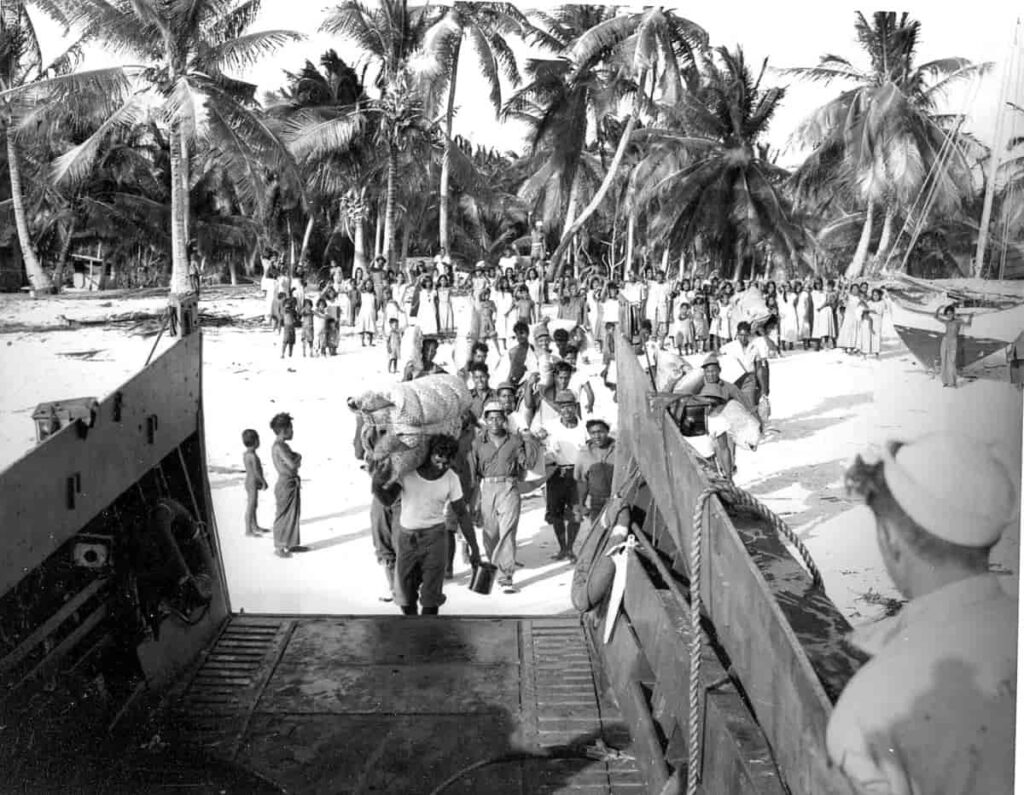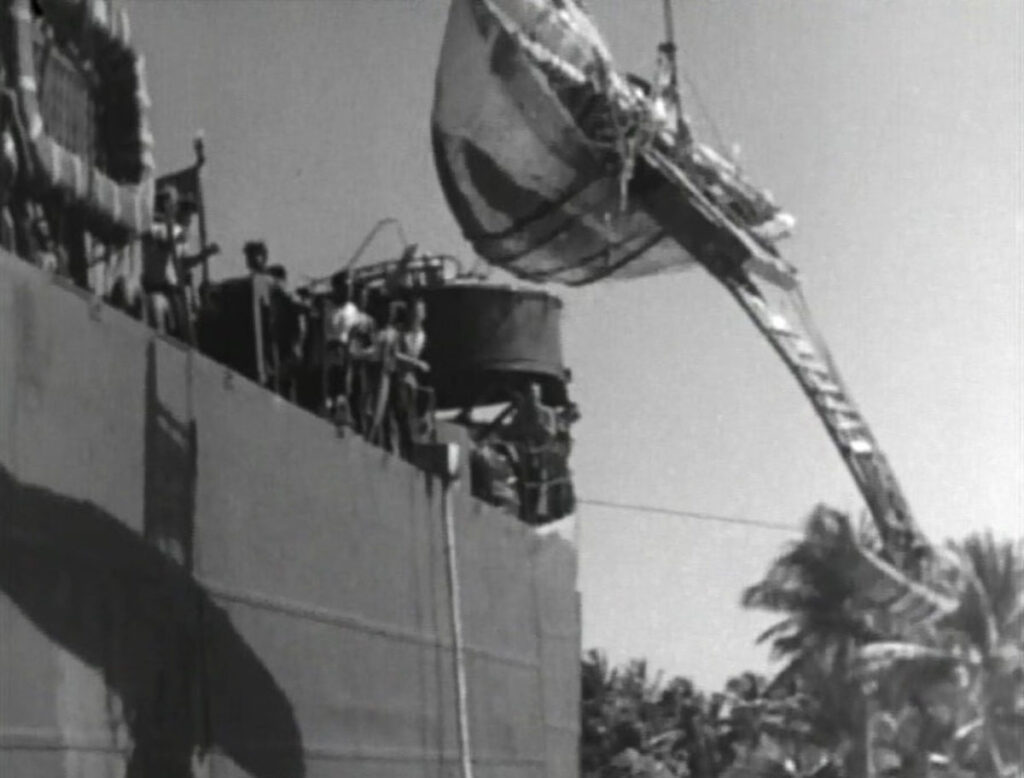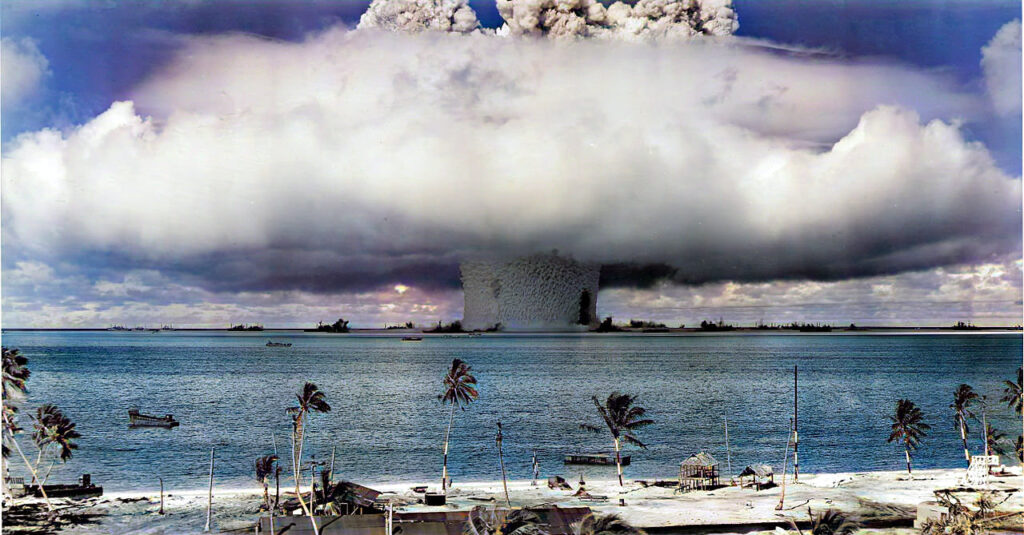
The Marshall Islands on the globe. Image from TUBS, CC BY-SA 3.0, via 
Map of the Marshall Islands. Image from Zuzu macumba at it.wikipedia, CC BY-SA 3.0, via Wikimedia Commons
The Marshall Islands, located in the northern Pacific Ocean, first became a primary target of Japanese and US occupation during World War II, when both sides sought an outpost west of Hawai’i but east of Asia. The US military eventually succeeded in driving out Japanese troops and taking control of the islands, and in the period after WWII, the newly formed United Nations granted the US administrative authority of Micronesia, the region of Oceania in which the Marshall Islands are located (Barker 348).

Thus began the UN-sanctioned American settler-colonial project in the Marshall Islands, including Bikini Atoll, a coral reef comprising 23 islands centered around a lagoon (Barker 348).

Intending to experiment with nuclear weapons technology on ancestral lands that the US viewed as expendable (and remote enough not to affect the land inhabited by white Americans), the US Navy chose Bikini Atoll as ground zero and forcefully removed the Indigenous peoples of those islands (Barker 348).

Within a matter of weeks, the Bikinian people were marched onto the U.S. Navy ships that would carry them and a few of their belongings to their “new home” (Niedenthal).

The US Navy moved the Bikinians to Rongerik Atoll, a string of islands ⅙ the size and 125 miles east of Bikini Atoll. Rongerik Atoll had been historically uninhabited due to its lack of food and water supply. The US administration left them with only a few weeks’ worth of food (Niedenthal).

While the Bikinians settled in on Rongerik, the U.S. quickly moved forward with their preparations to conduct violent and destructive nuclear tests on their ancestral lands.

Between 1946 and 1958, the US detonated 67 nuclear weapons across the Marshall Islands, including a bomb launched at Bikini Atoll that was one thousand times more powerful than the one that destroyed Hiroshima at the end of WWII (Barker 349). 23 weapons were detonated on Bikini Atoll alone, vaporizing four of its islets (Hanley).

Nuclear fallout assaulted other nearby Native Islanders, who were not warned that the ash raining down on their lands were toxic (Niedenthal).

Following their relocation, Bikinians faced deplorable conditions and near-starvation. In a time of desperation and despair, Bikini Native Lore Kessibuki (1914-1994) composed the song Bikinian Anthem in 1946, and it is still sung across the Bikini diaspora today (Barker 355-356). Translated into English, the lyrics are:
No longer can I stay; it’s true.
No longer can I live in peace and harmony.
No longer can I rest on my sleeping mat and pillow
Because of my island and the life I once knew there.
The thought is overwhelming
Rendering me helpless and in great despair.
My spirit leaves, drifting around and far away
Where it becomes caught in a current of immense power—
And only then do I find tranquility.
Quoted in Barker 355.
“For Kessibuki and the Bikinians who have continued to sing the anthem since his death, leaving Bikini was akin to ripping the soul of the people from their bodies, as their islands and the life they once knew were gone,” writes Holly Barker (355).

After near-starvation for a number of years on the hostile Rongerik Atoll, the Bikinian people were relocated yet again to Kili Island, another small island hundreds of miles from Bikini with inadequate food and water sources. Many Bikinians remain there today, though the Bikini diaspora stretches much farther.
Today, the 161 Bikinians who were removed from their ancestral lands have grown to thousands around the world. Global warming and rising sea levels endanger their new home on Kili, surviving largely on a restricted diet supplied by the U.S, since Kili does not have sufficient food resources (Niedenthal).
Bikinian poet and activist Kathy Jetñil-Kijiner writes in “Dome Poem Part III”:
You were a whole island, once. You were breadfruit trees heavy with green globes of fruit whispering promises of massive canoes. Crabs dusted with white sand scuttled through pandanus roots. Beneath looming coconut trees beds of ripe watermelon slept still, swollen with juice. And you were protected by powerful irooj, chiefs birthed from women who could swim pregnant for miles beneath a full moon.
Then you became testing ground. Nine nuclear weapons consumed you, one by one by one, engulfed in an inferno of blazing heat. You became crater, an empty belly. Plutonium ground into a concrete slurry filled your hollow cavern. You became tomb. You became concrete shell. You became solidified history, immoveable, unforgettable.
You were a whole island, once.
Who remembers you beyond your death? Who would have us forget that you were once green globes of fruit, pandanus roots, and whispers of canoes? Who knows the stories of the life you led before?
There’s a story of a turtle goddess. She gifted one of her sons, Letao, a piece of her shell, anointed with power. A leathery green fragment, hollow as a piece of bark. It gave Letao the power to transform into anything, into trees and houses, the shapes of other men, even kindling for the first fire he almost
burned us
alive
I am looking for more stories. I look and I look.
Kathy Jetñil-Kijiner
Works Cited
Barker, H. M. (2019). Unsettling SpongeBob and the Legacies of Violence on Bikini Bottom. The Contemporary Pacific, 31(2), 345-379. doi:10.1353/cp.2019.0026
Hanley, C. J. (2004, May 16). Islanders Yearn to Return to Bikini Atoll. Retrieved November 19, 2020, from https://www.latimes.com/archives/la-xpm-2004-may-16-adfg-bikini16-story.html
Jetñil-Kijiner, K. (2019, February 13). Dome Poem Part III: “Anointed” Final Poem and Video. Retrieved November 19, 2020, from https://www.kathyjetnilkijiner.com/dome-poem-iii-anointed-final-poem-and-video/
Niedenthal, J. (n.d.). A Short History of the People of Bikini Atoll. Retrieved November 19, 2020, from https://www.bikiniatoll.com/history.html
